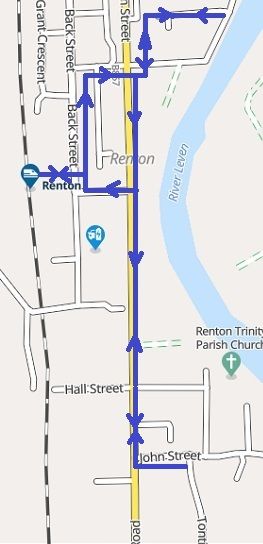The Renton Ramble Two
There can be few if any places in the World, where literally pivotal footballing history can be so concentrated, than Dunbartonshire's Renton. It was the village team, which, in 1875 by reaching the second ever Scottish Cup Final provided the first provincial challenge to Glasgow's place in Scottish football. Admittedly that final was lost but it would only be two season's later that Vale of Leven, the club from neighbouring Alexandria, would complete the task and for a while be predominant. However, Renton would regroup and from 1883 a new group of players would emerge its working-class streets and change football forever. If Vale of Leven can be said to have been the first, successful working-man's team then Renton, astoundingly already one hundred and thirty-five years ago, and after a five year incubation is the source of the modern game. Football might have been invented England but in and from 1888 both north and south of the border it was changed irrevocably. It was the year Renton first won the Scottish Cup for the second time and then beat England's West Bromwich Albion and Preston North End, that and the next season's winners of the English FA Cup with Preston also in 1889 first League Champions. And they did first of all by employing a new style of football developed specifically in the village and secondly with a group of fifteen or so young men, who emerged from a collection of then teaming streets that even today may be explored in a matter of minutes following our first Renton Ramble.
But the flow of village talent did not stop there. Two more waves of young men emerged approximately five years apart over the next decade. Most were persuaded by English clubs to earn a living from football that was initially officially denied them in their own land but, as professionalism came to Scotland, other teams in our own game beyond Celtic came in to draw from the pool. And in doing so these younger products of Renton youth took the same new style now not only into the wider World but across our land. The streets of the Second Wave can be explored on-line below or using those notes in reality at a stroll on the ground.
So now, if your curiosity is again pricked, then here is the history that may start to bring it all to life.
Out of the station to the T-junction you turn left into the upper part of Back St. There Duncan McLean grew up before a season at full-back at Renton and five more on Merseyside. He started at Everton but on the split remained at Anfield and newly-formed Liverpool. In fact he was a founder-member of the The Team of the Macs.
Up Back St. and first on the right is King St. Take it down to Main St., turn left once more, cross and cut through the alley into Thimble St.. There at No. 37 lived the Kelsos. Bob would be a member of Renton's greatest team. James, his younger brother, also a half-back would also briefly join Liverpool, not be successful and return home. In fact his life would be tragically short. He would commit suicide. But there is some joy in the sadness. A decade later his widow would marry the then also widowed Duncan Mclean and their families would combine, joined by a further son.
Now retraced your steps back onto Main St., turn right and follow it through the centre of the village to its junction with Hall St. to right and Leven St. to the left.
Here there was once the village's public park, before the creation of Tontine Park, from 1878 Renton F.C.'s ground, and the present day one across the road. Here is Trinity Place, once Church Place and, it is thought, Park Buildings and Park Terrace. The first was the home of Billy Fleming, who would go on to Partick Thistle, Sheffield United and Dundee amongst other. Park Buildings was where David Hannah was a teenager. He would be another to join Sunderland and Liverpool but also Arsenal. And Park Terrace was where Alex Brady stayed at aged ten, as did John Harvey, newly arrived from Glasgow and going on to ply his trade again at Sunderland plus Clyde and Newcastle, where he became a trainer of its great team of the 1910s.
And then there it perhaps time for a quick walk a quarter of a mile southward to Tontine Park. The name survives as a street at the centre of a housing-estate. That is before it is back for walkers at least to the starting point at the station, the present and onward.
